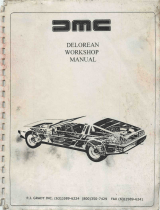
Q:\1035 Latch Replacement (2)
1992-12-02 Rev.OJ
Note 1: The latch has to be held in place quite solidly, just loose enough for the spring to pull it back. If
the latch is too loose, remove the bolt and add one more thin steel washer under the head of the
bolt, then retighten very firmly.
6. Hook the new spring to the spring bracket and to the latch bracket. Adjust the spring bracket,
if necessary, by choosing one of the other holes "A" provided for that purpose (see fig.2).
7. From the door, remove and discard the door catch and the 4 - 1/4-28 Flat Head Screws.
-
8. Install the new door catch and firmly affix it with the 4 new screws provided (see fig.2).
Adjustment Procedure: DOOR
9. Close the door and check the space between the door and the oven frame, top, bottom and
sides. There should be 3/8" space all around (see fig.l).
10. Left to right adjustments can be made by loosening either the top and/or bottom hinge
screws, moving the door, then re-tightening the screws again.
11. The height at the hinge side can be adjusted by removing or adding washers as required.
Note 2: If the hinge side is ok and only the latch side needs to be raised or lowered, this too can be done
with the hinges. Raising the latch side can be done by moving the top hinge to the left or moving
the bottom hinge to the right. The opposite can be achieved by doing the reverse.
Adjustment Procedure: LATCH
n- -
12. Close the door and check the space "B" (see fig.1) between the door and the latch. There should be about 1/32"
space between the two. Much less than that can cause the door to hit the latch and more than that reduces the latch
and catch contact surfaces and will result in premature wear.
13. If the space is less than 1/32", pull the door to the left to gain proper clearance.
14. If the space is more than 1/32", and there is a 1/8" clearance "c" at the right ofthe latch, pull the door to the
right. But if the latch is too far to the right, less than 1/8", proceed as outlined
in par.15 below.
15. Open the door, then, using a big solid screw driver or similar object and a heavy hammer, administer one
or two heavy blows along impact line (see fig. 1 & 2) onto the welds to force the latch farther to the left
against the door.
16. Close the door and recheck the clearance between the latch and the door. Repeat the above if
Necessary.
2 of 4





